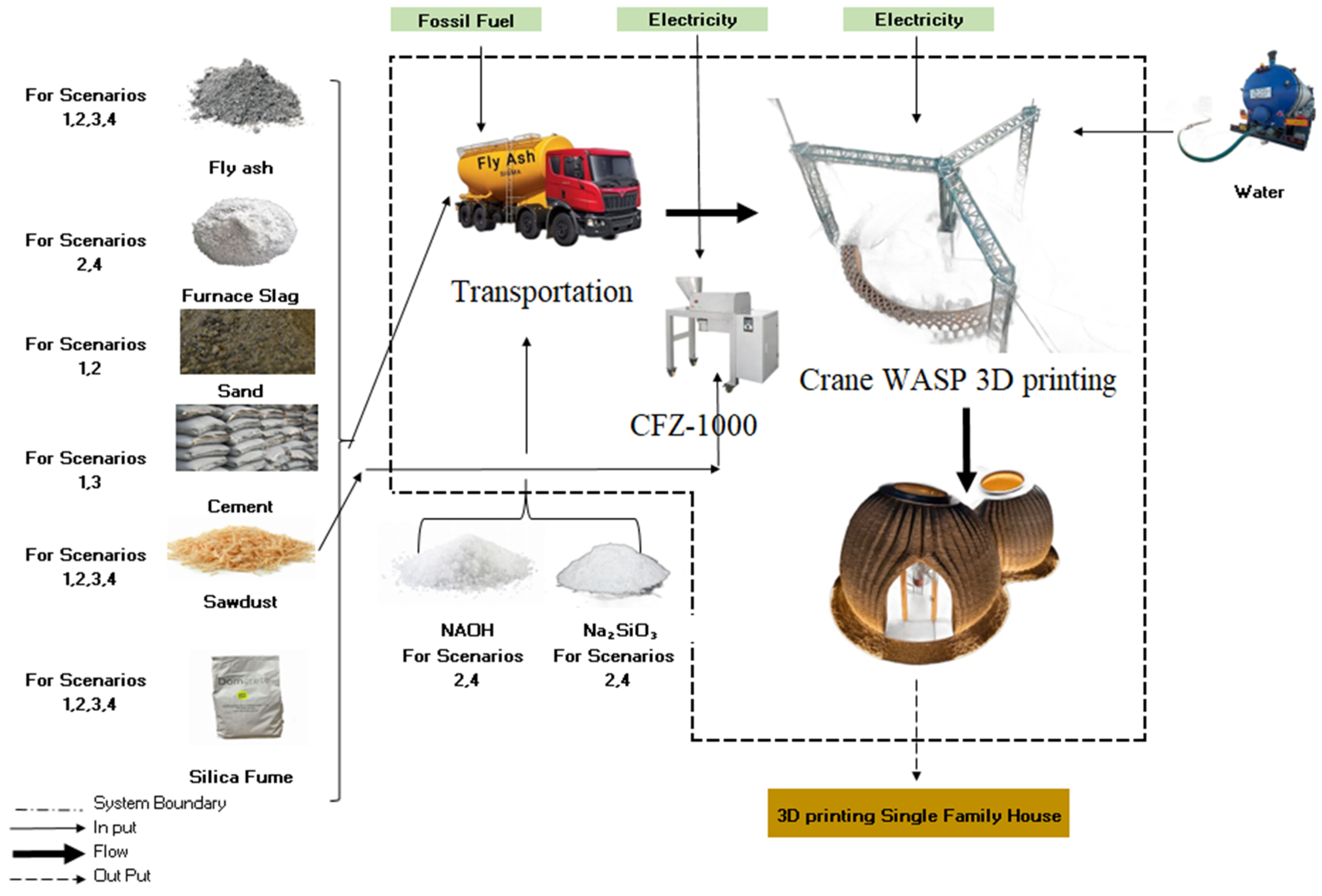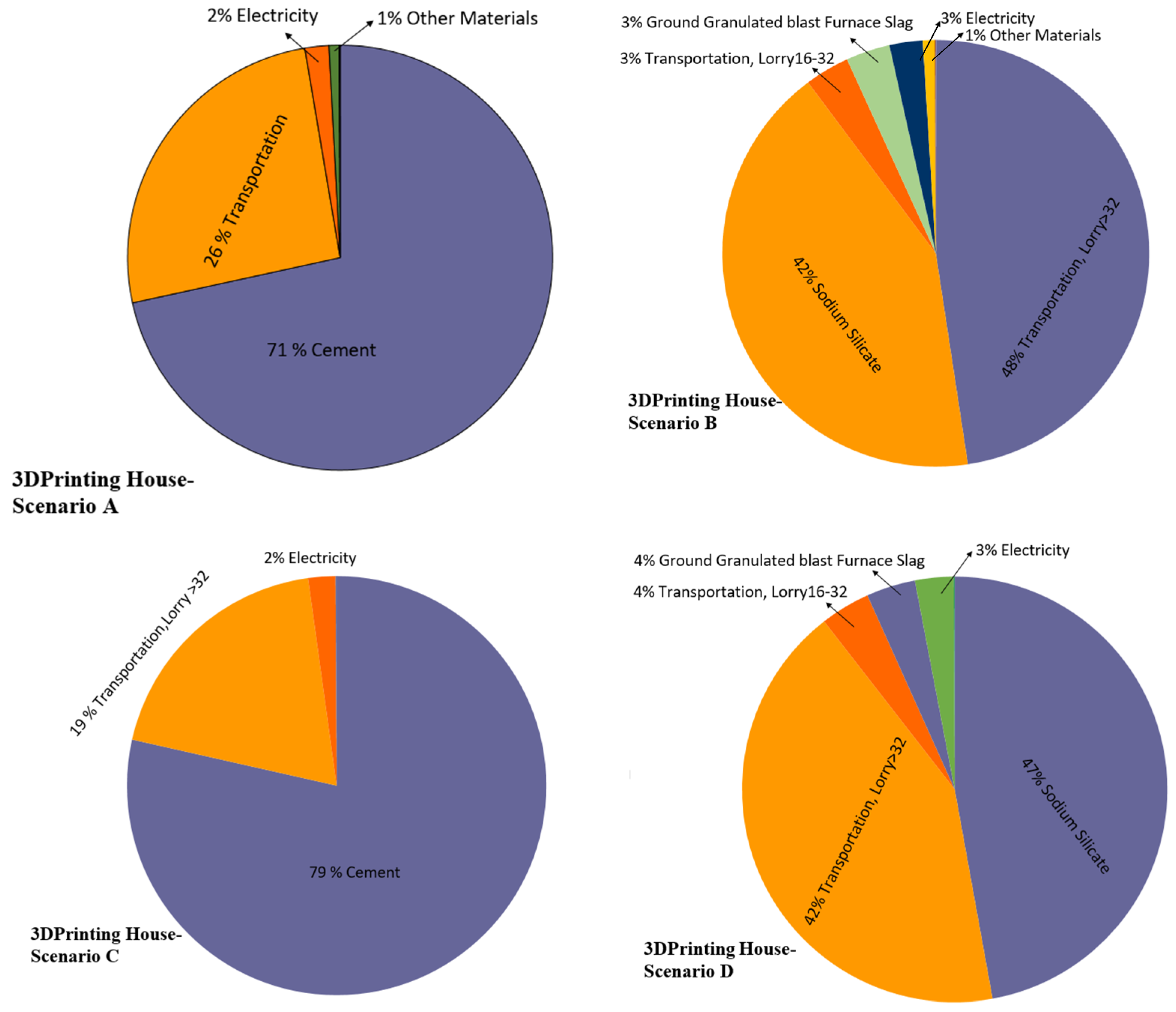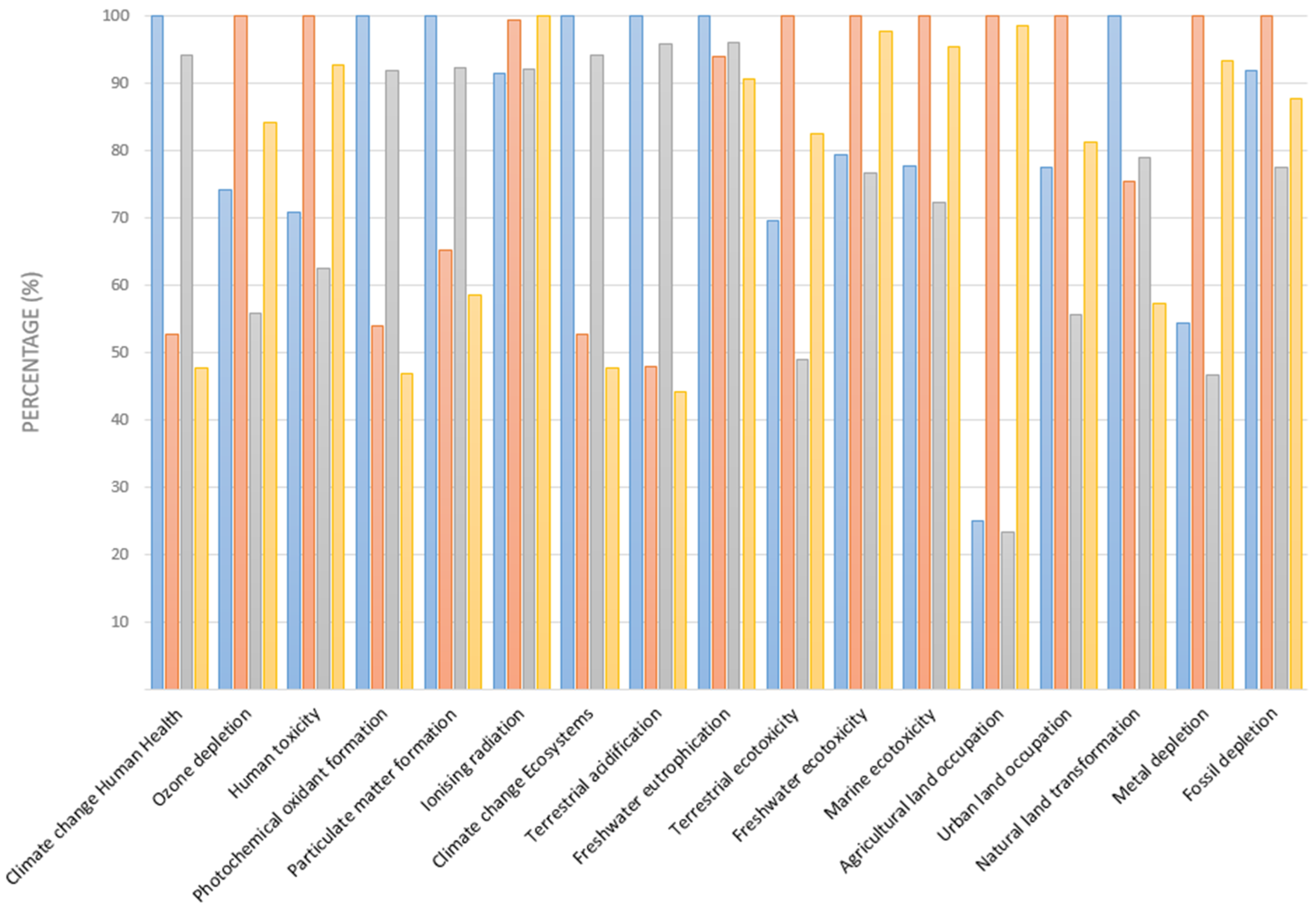Sustainable Structures Unveiled: Navigating the Environmental Landscape of 3D Printing in Construction †
Abstract
1. Introduction
2. Life Cycle Assessment
2.1. Goal, Scope, Functional Unit, and System Boundary
2.2. Life Cycle Inventory
2.3. Life Cycle Impact Assessment
3. Finding and Interpretation
Comparing Scenarios
4. Conclusions
Author Contributions
Funding
Institutional Review Board Statement
Informed Consent Statement
Data Availability Statement
Conflicts of Interest
References
- Zhang, R.C.; Wang, L.; Xue, X.; Ma, G.W. Environmental profile of 3D concrete printing technology in desert areas via life cycle assessment. J. Clean. Prod. 2023, 396, 136412. [Google Scholar] [CrossRef]
- Motalebi, A.; Khondoker, M.A.H.; Kabir, G. A Systematic Review of Life Cycle Assessments of 3D Concrete Printing. Sustain. Oper. Comput. 2023, 5, 41–50. [Google Scholar] [CrossRef]
- Beltrami, M.; Orzes, G.; Sarkis, J.; Sartor, M. Industry 4.0 and sustainability: Towards conceptualization and theory. J. Clean. Prod. 2021, 312, 127733. [Google Scholar] [CrossRef]
- Sakib-Uz-Zaman, C.; Khondoker, M.A.H. Polymer-Based Additive Manufacturing for Orthotic and Prosthetic Devices: Industry Outlook in Canada. Polymers 2023, 15, 1506. [Google Scholar] [CrossRef] [PubMed]
- Ghaffar, S.H.; Corker, J.; Fan, M. Additive manufacturing technology and its implementation in construction as an eco-innovative solution. Autom. Constr. 2018, 93, 1–11. [Google Scholar] [CrossRef]
- Rangel, B.; Guimarães, A.S.; Lino, J.; Santana, L. (Eds.) 3D Printing for Construction with Alternative Materials; Springer: Berlin/Heidelberg, Germany, 2023. [Google Scholar] [CrossRef]
- 3d Printer House|Crane WASP|3D Printers|WASP. 2023. Available online: https://www.3dwasp.com/en/3d-printer-house-crane-wasp/ (accessed on 7 August 2023).
- Persad, C.S. “This Is a Continuation of Genocide”: Examining the Pathologization of Indigeneity in the 2016 Suicide Crisis and State of Emergency in Attawapiskat First Nation. 2017. Available online: https://yorkspace.library.yorku.ca/xmlui/handle/10315/35146 (accessed on 7 August 2023).
- How Big Is a House? Average House Size by Country—2023—Shrink That Footprint. 2023. Available online: https://shrinkthatfootprint.com/how-big-is-a-house/ (accessed on 1 August 2023).
- Profile Table, Census Profile, 2021 Census of Population—Attawapiskat 91A, Indian reserve (IRI) [Census subdivision], Ontario. 2021. Available online: https://www12.statcan.gc.ca/census-recensement/2021/dp-pd/prof/details/page.cfm?Lang=E&DGUIDlist=2021A00053560051&GENDERlist=1&STATISTIClist=1&HEADERlist=0 (accessed on 1 August 2024).
- The Ideal House Size and Layout to Raise a Family. 2023. Available online: https://www.financialsamurai.com/the-ideal-house-size-and-layout-to-raise-a-family/ (accessed on 1 August 2023).
- Le, T.T.; Austin, S.A.; Lim, S.; Buswell, R.A.; Gibb, A.G.; Thorpe, T. Mix design and fresh properties for high-performance printing concrete. Mater. Struct. 2012, 45, 1221–1232. [Google Scholar] [CrossRef]
- Panda, B.; Tan, M.J. Experimental study on mix proportion and fresh properties of fly ash based geo polymer for 3D concrete printing. Ceram. Int. 2018, 44, 10258–10265. [Google Scholar] [CrossRef]
- Agustí-Juan, I.; Müller, F.; Hack, N.; Wangler, T.; Habert, G. Potential benefits of digital fabrication for complex structures: Environmental assessment of a robotically fabricated concrete wall. J. Clean. Prod. 2017, 154, 330–340. [Google Scholar] [CrossRef]
- Alhumayani, H.; Gomaa, M.; Soebarto, V.; Jabi, W. Environmental assessment of large-scale 3D printing in construction: A comparative study between cob and concrete. J. Clean. Prod. 2020, 270, 122463. [Google Scholar] [CrossRef]
- Mehdi, N.; Ghazanfarah, H.; Iman, F.; Huseien, G.F.; Bedon, C. Investigating the fresh and mechanical properties of wood sawdust-modified lightweight geopolymer concrete. Adv. Struct. Eng. 2023, 26, 1287–1306. [Google Scholar] [CrossRef]
- Youssef, M.; Abbas, L. Applying 3D printing technology in construction sustainable houses. Archit. Plan. J. (APJ) 2023, 29, 4. [Google Scholar] [CrossRef]
- Mohammad, M.; Masad, E.; Al-Ghamdi, S.G. 3d concrete printing sustainability: A comparative life cycle assessment of four construction method scenarios. Buildings 2020, 10, 245. [Google Scholar] [CrossRef]
- Abdalla, H.; Fattah, K.P.; Abdallah, M.; Tamimi, A.K. Environmental footprint and economics of a full-scale 3d-printed house. Sustainability 2021, 13, 11978. [Google Scholar] [CrossRef]
- Sambucci, M.; Biblioteca, I.; Valente, M. Life Cycle Assessment (LCA) of 3D Concrete Printing and Casting Processes for Cementitious Materials Incorporating Ground Waste Tire Rubber. Recycling 2023, 8, 15. [Google Scholar] [CrossRef]
- Yao, Y.; Hu, M.; di Maio, F.; Cucurachi, S.; Seager, T. Life cycle assessment of 3D printing geo-polymer concrete: An ex-ante study. J. Ind. Ecol. 2020, 24, 116–127. [Google Scholar] [CrossRef]




| Features | Tecla Project | Attawapiskat Project |
|---|---|---|
| Size of house | 60 m2 | 130 m2 |
| Material usage (18 mm nozzle) | 38.151 m3 | 82.66 m3 |
| Printing time | 200 h | 433.3 h |
| Electricity consumption | 6 KW | 13 KW |
| Items | Unit | Scenario A | Scenario B | Scenario C | Scenario D | Distance t* km |
|---|---|---|---|---|---|---|
| Fly ash | kg | 13,638.90 | 49,805.13 | 13,638.90 | 49,805.13 | 0.955 |
| Slag | kg | - | 8788.41 | - | 8788.41 | 0.955 |
| Sand | kg | 51,290.53 | 43,946.19 | - | - | 0.683 |
| Na2SiO3 | kg | - | 14,498.56 | - | 14,498.56 | 1.336 |
| NaOH | kg | - | 11,869.98 | - | 11,869.98 | 1.336 |
| Water | kg | 19,177.12 | 4882.73 | 19,177.12 | 4882.73 | 0.100 |
| Cement | kg | 47,860.14 | - | 47,860.14 | - | 0.683 |
| Sawdust | kg | 51,290.53 | 43,946.19 | 102,581.06 | 87,892.38 | 0.100 |
| Silica fume | kg | 6860.78 | 4882.73 | 6860.78 | 4882.73 | 0.955 |
| Electricity | MJ | 21,293.99 | 21,148.57 | 22,309.54 | 22,018.71 | - |
Disclaimer/Publisher’s Note: The statements, opinions and data contained in all publications are solely those of the individual author(s) and contributor(s) and not of MDPI and/or the editor(s). MDPI and/or the editor(s) disclaim responsibility for any injury to people or property resulting from any ideas, methods, instructions or products referred to in the content. |
© 2024 by the authors. Licensee MDPI, Basel, Switzerland. This article is an open access article distributed under the terms and conditions of the Creative Commons Attribution (CC BY) license (https://creativecommons.org/licenses/by/4.0/).
Share and Cite
Motalebi, A.; Khondoker, M.A.H.; Kabir, G. Sustainable Structures Unveiled: Navigating the Environmental Landscape of 3D Printing in Construction. Eng. Proc. 2024, 76, 44. https://doi.org/10.3390/engproc2024076044
Motalebi A, Khondoker MAH, Kabir G. Sustainable Structures Unveiled: Navigating the Environmental Landscape of 3D Printing in Construction. Engineering Proceedings. 2024; 76(1):44. https://doi.org/10.3390/engproc2024076044
Chicago/Turabian StyleMotalebi, Arash, Mohammad Abu Hasan Khondoker, and Golam Kabir. 2024. "Sustainable Structures Unveiled: Navigating the Environmental Landscape of 3D Printing in Construction" Engineering Proceedings 76, no. 1: 44. https://doi.org/10.3390/engproc2024076044
APA StyleMotalebi, A., Khondoker, M. A. H., & Kabir, G. (2024). Sustainable Structures Unveiled: Navigating the Environmental Landscape of 3D Printing in Construction. Engineering Proceedings, 76(1), 44. https://doi.org/10.3390/engproc2024076044








